Searching for the “Art in You”
Best known for his haunting installations of red LED digital counters, Tatsuo Miyajima’s largest solo show in Japan for nearly a decade reveals the artist’s recent exploration of a more socialized artistic practice, while remaining focused on death, life, and the possibilities of art in-between. ‘Art in You’ is not only the title of the current exhibition, but also the theme of Miyajima’s work in recent years, by which the Miyajima summarizes his belief that art is the expression of a latent creativity within each of us.
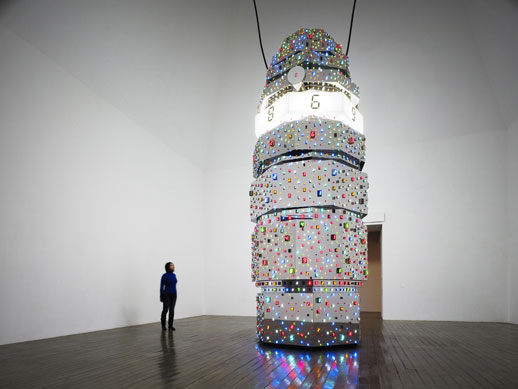
The centerpiece of the show is a new sculptural work titled Hoto (2008), located at the heart of the exhibition. At over five metres tall and two metres wide it is a huge, literally towering presence; its mirrored surface inlaid with an array of variously sized, multicoloured LED counters. Unlike the somber anonymity of Miyajima’s signature work of the 1990s, such as the first work in the show, Death of Time (1990-92); or the representative piece that he showed in the Japan Pavilion at the 1999 Venice Biennale, Mega Death1 (1999), Hoto echoes the colour and vibrancy of recent photographic works also on show in Mito. The scintillating countdown colours and mirrored surfaces conjure images of a “bejeweled tower”, suggestive of the work’s title2. The angled, mirrored surfaces of the somewhat circular structure play with the viewer’s reflection, allowing you to visually locate yourself ‘in the art’, a direct reference to the overall ‘Art in You’ concept of positive interactivity and inter-connectedness3.
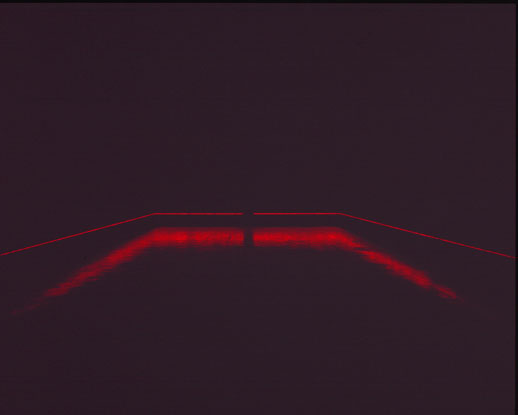
The exhibition notes locate Hoto and the other recent works in terms of the artist’s post-9/11 hope for peace and human community, using art as a conduit. These sentiments are at the heart of Miyajima’s more recent collaborative projects—examples of which were held as a part of the current exhibition, in which audience participants are photographed with numbers of their choice painted on some part of their body, against the background of the workshop location (such as Hiroshima, Okinawa, and others). Images from this series titled ‘Counter Skin’ (2007) effectively make up the visual bulk of the show, filling the two larger exhibition rooms. However, despite their larger-than-life size, and high-gloss Perspex finish, they seem to remain ‘artistic’ documents of a collaboration process. As such, one room of images is ample space in which to grasp Miyajima’s workshop concept and appreciate the aesthetic outcomes of the project, while the second room of similar images come across as somewhat unnecessary. I can admit wondering for a moment whether they were not simply included in such numbers so as to fill the ample exhibition space. With so much of the exhibition space given to these photographs, one couldn’t help wanting to see more diverse examples of Miyajima’s recent work…
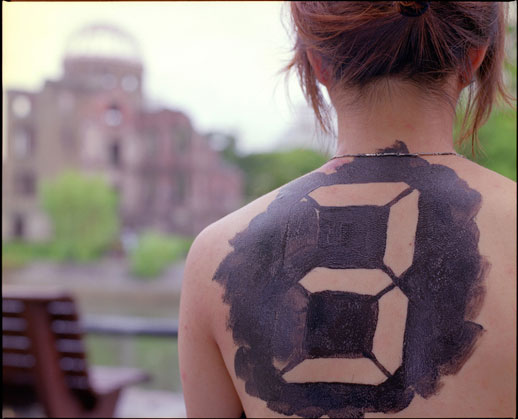
Granted, a few recent projects are found scattered along the long passage adjacent to the main exhibition rooms. One such work is Death Clock (also produced through the caravan workshops, 2007) in which blurry, monotone images of the participants are overlaid with a long line of digits counting down. The seconds that you see elapsing on-screen are counting down to a time in the future, which each participant has chosen as their time of death. While the frank nature of the project and sleek design could be quite powerful in a different installation, here they have been scattered down the hall ‘next-door’ on a number of slim, new computers; a display more reminiscent of a museum’s educational program, rather than a curatorial outcome. This bolsters a sense of hierarchy between the ‘important’ works in the main exhibition space and these ‘additional’ pieces. Also on display here are some never-before-seen drawings, which seem to be literally and figuratively ‘caricatures’ of the more sensitive manipulation of commercial visual technology that Miyajima has become known for in his work with LEDs.
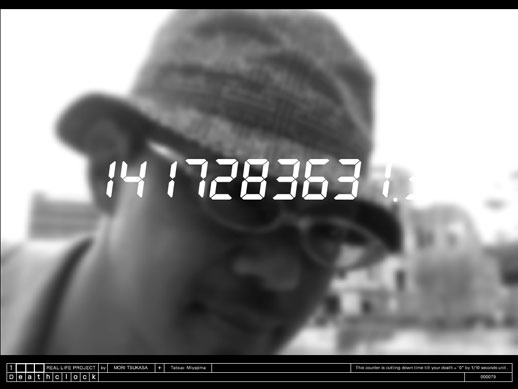
While Hoto commands a central place in terms of its size, and as a development of Miyajima’s signature aesthetic and use of materials, the other works, and particularly the prominence given to the photographs that resulted from the traveling workshops, all indicate a more feel-good collaborative message.
This is felt most clearly in the frankly amateurish Counting in You (2008), a ‘mural’ piece at the beginning of the exhibition that consists of phrases such as ‘peace in you’, ‘art in you’ and ‘hope in you’ painted on the wall, where in place of each word ‘you’ the artist has stuck to the wall an actual fragment of mirror, albeit many of them at a height which precludes them actually reflecting the viewer. Moreover, this is such a contrast to the first piece, Death of Time, that one cannot help but wonder whether the earlier signature work has been included simply as a token of what many people have in mind when they think of the artist, or whether this juxtaposition is designed to demonstrate the extent to which the artist has moved beyond his signature style.
The lack of rigour in a work such as Counting in You, pointed to a broader question concerning older or established artists, who have built a career working with recent technologies, yet then ‘return’ to more ‘traditional’ forms of art (paint, editioned prints, or even photography) as a late career move. What angst, or art-world demands, or social pressure prompts such decisions? Are these self-imposed? And how do we critically deal with such art, which seems ironically weakened by the very strength of that artist’s earlier work?
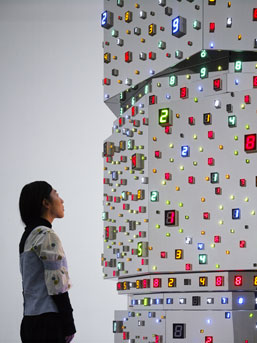
Considering the space available in Mito, and the fact that one usually sees Miyajima’s work in a larger group show or permanent collection, perhaps I was hoping to see more of a retrospective-style exhibition. While it may be too early for a real retrospective (was this another point of the show?), it would have been interesting to see more of his seminal pieces from the 1990s in a space that allowed comparison, and resonance, between individual works. Although the current exhibition reiterates the artist’s key concerns of life and death, mediated through the symbolic use of numbers to represent the cluster of complex individuals ‘we’ are, the artwork seems to be specifically conceived to counter (a word that had often appeared in Miyajima’s work) his stark aesthetic language of the pre-9/11 1990s.
One of my one of my earliest memories of any specific artwork, is a wall of constantly changing, yet ever-present, red numbers. As a longtime unconscious fan, it is impressive to see a monumental new piece like Hoto, just as it is important to note the artist’s more recent projects focused on ‘interaction’, rather than exhibition. However, the overall impression of this exhibition is one of imbalance. The patchwork outcome does not maintain the artist’s vigour throughout the sizable exhibition space. The somewhat uneasy spectrum of work leaves one wondering whether the organization was rushed, or if more exciting options were lost in conciliatory negotiations. Whatever the reason, despite the optimism and genuine energy one sees in the recent directions of Miyajima’s work, as an exhibition, ‘Art in You’ seemed full of possibilities, which unfortunately largely remain just that: possibilities, awaiting more concrete expression.
—
1 Note that this work is not on display in the current exhibition
2 The character for hō can mean ‘jewel’ or ‘treasure’, and tō, ‘tower’. However, this word has long been used as a specific architectural term, basically referring to the form of some two-storied pagodas, which Miyajima also references in the structure of his tower.
3 Explanations of the concept ‘Art in you’ can be found on the artist’s website, www.tatsuomiyajima.com.
Olivier Krischer
Olivier Krischer



